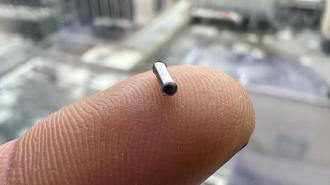A new drug delivery system for pancreatic tumors could dramatically decrease medication dosages — helping patients avoid unpleasant side effects without sacrificing efficacy.
The challenge: With just half a million new diagnoses every year, pancreatic cancer is relatively rare, but it’s also notoriously difficult to detect and treat.
“Pancreatic cancer cells are able to survive a lot of things — radiation therapy, chemotherapy, having no oxygen or blood supply,” oncology researcher Arturo Loaiza-Bonilla, who wasn’t involved in the new study, explained in 2020. “They just survive for a long time.”
Pancreatic cancer is relatively rare, but it’s also notoriously difficult to detect and treat.
As a result, more than 80% of patients diagnosed with the most common form of pancreatic cancer — pancreatic ductal adenocarcinoma (PDAC) — die within the first year after diagnosis, and fewer than 10% live for five or more years after.
The challenge: To treat tumors in the pancreas and elsewhere in the body, doctors can sometimes administer monoclonal antibodies (mAbs), which are lab-made proteins that bind to cancer cells and prevent their growth, help the immune system attack them, or deliver toxins that kill the cells.
Because mAbs are typically administered intravenously, they spread throughout patients’ entire bodies, often resulting in unpleasant side effects. This systemic approach also requires doctors to administer oversized doses to ensure enough of the mAbs reach the tumor to be effective.
The idea: Researchers at Houston Methodist have developed a drug delivery system smaller than a grain of rice that can be loaded up with mAbs and then implanted directly into a tumor with a minimally invasive procedure.
The stainless steel device, which the researchers call a “nanofluidic drug-eluting seed” (NDES), then releases the mAbs right where they’re needed, in a slow and sustained manner over the course of two weeks.
“One animal model remained tumor-free for the 100-days of continued observation.”
Corrine Ying Xuan Chua
The results: When the drug delivery system was used to release mAbs inside pancreatic tumors in mice, it produced the same positive effect as systemic administration, but with a dose four times smaller and without triggering any treatment-related adverse effects in the animals.
“One of the most exciting findings was that even though the NDES device was only inserted in one of two tumors in the same animal model, we [also] noted shrinkage in the tumor without the device,” said co-corresponding author Corrine Ying Xuan Chua.
“This means that local treatment with immunotherapy was able to activate the immune response to target other tumors,” she continued. “In fact, one animal model remained tumor-free for the 100-days of continued observation.”
The advance: The Houston Methodist team didn’t invent the idea of delivering cancer therapeutics directly to tumors, but the key to making that approach work is getting the medicines to stay put for an extended period of time.
Existing implants can’t provide the extended release of Houston Methodist new drug delivery system.
When delivered via an injection, therapies tend to leak out of tumors rapidly, requiring the patient to undergo the administration procedure repeatedly — in their paper, the researchers note that some pancreatic cancer patients may receive up to 80 injections over the course of two months.
Meanwhile, existing implants designed to deliver therapies directly into tumors release their payloads too quickly — they can’t provide the extended release of Houston Methodist’s NDES.
Looking ahead: The researchers plan to continue studying the safety and effectiveness of their drug delivery system, with the goal of having it ready to deliver mAbs and other immunotherapeutics to pancreatic tumors in patients within five years.
“Our goal is to transform the way cancer is treated,” said co-corresponding author Alessandro Grattoni. “We see this device as a viable approach to penetrating the pancreatic tumor in a minimally invasive and effective manner, allowing for a more focused therapy using less medication.”
We’d love to hear from you! If you have a comment about this article or if you have a tip for a future Freethink story, please email us at [email protected].






